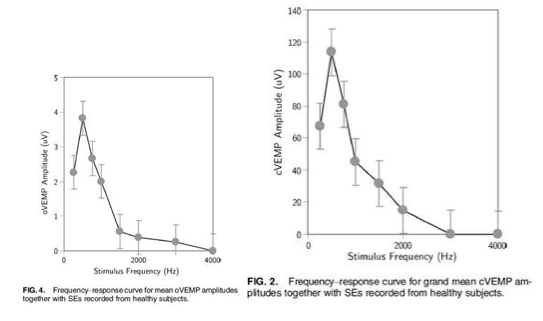Subscribe to the Interacoustics Academy newsletter for updates and priority access to online events
Training in VEMP
-
VEMP Tuning: Clinical Application (1/3)
-
VEMP Tuning: Clinical Application (2/3)
-
VEMP Tuning: Clinical Application (3/3)
-
oVEMP: An Introduction
-
cVEMP: An Introduction
-
Course: Balance Testing for Beginners
-
Course: Balance Testing for Intermediates
-
How Many Sweeps in cVEMP Testing?
-
How to Diagnose SSCD with cVEMPs
-
Accounting for Muscle Asymmetries in cVEMP
-
VEMP and vHIT in Vestibular Neuritis Patients
-
Can You Use VEMPs to Diagnose Meniere's Disease?
-
Getting started: VEMP
-
Vestibular Evoked Myogenic Potentials - Introduction
-
Cervical VEMP - Patient Preparation for Assessment
-
Cervical VEMP - Protocol & Parameter Selection
-
Cervical VEMP - Running the Test
-
Cervical VEMP - Modifications of the Assessment
-
Ocular VEMP - Patient Preparation for Assessment
-
Ocular VEMP - Modifications of the Assessment
-
Ocular VEMP - Running the Test
-
Ocular VEMP - Protocol & Parameter Selection
-
Vestibular Evoked Myogenic Potentials (VEMP): A Complete Guide
-
oVEMPs: Una introducción
-
Introducción a los cVEMP
-
Evaluación otolítica: Más allá de los VEMPs
-
Potentiels myogéniques évoqués vestibulaires (VEMP)
-
Potenciales Miogénicos Evocados Vestibulares (VEMP): Una Guía Completa
Why Use the CE-Chirp® in VEMP Testing?
Description
This is a pretty interesting question for several reasons but the answers to your question is not easy. The direct answer is we do not know what the rationale is for any advantage of CE-Chirp® over tonebursts or clicks (the conventionally used stimuli). We don’t think the answers have been established in the literature yet. I will elaborate:
Here below is a tuning curve for oVEMP and cVEMP taken from Sandhu et al (2012).

n.b. there are several key VEMP parameters (amplitude, latency, interaural asymmetry, morphology) but these comments just refer to amplitude for now.
The obvious thing to note from these tuning curves (which reflect the same pattern as other such published curves) is that the amplitude is greatest in the low frequencies, peaking at 500 Hz, but drops off markedly above 1000 Hz for both cVEMP and oVEMP. The frequency range of interest for obtaining the largest VEMPs are 250-1000Hz – perhaps partly related to the middle ear transfer function (for AC VEMPs) and partly related to the fluid impedance properties of the vestibule.
As you are perhaps aware, we have currently two conventional stimuli. The click, broadband, would theoretically produce the largest response. Also we have the tonebursts and although frequency specific, their longer duration (several ms depending on frequency, compared with the 0.1 µs click) produces a greater intensity stimulus (energy per unit time). So, the 500 Hz toneburst is often preferred as this frequency corresponds to the peak in the tuning curves above.
The interest in the CE-Chirp® (e.g. centred on 500 Hz) is that it should cover the frequency range where the tuning curve peaks (500 Hz NB CE-Chirp® is 360-720 Hz).
On the other hand this is slightly narrower than the 250-1000Hz range, and so recently a special VEMP Chirp has been developed (Walther and Cebulla designed a 250-1000Hz Chirp ).
Walther and Cebulla found some advantages to the tonebursts in amplitude but even still, what is not well understood is why a rising Chirp should be relevant for the utricle and saccule. The rising Chirp i.e. temporally separating the frequency components by starting at the low frequency end of the spectrum and progressively moving to higher frequencies) is relevant to compensate for the tonotopic arrangement of hair cells in the cochlea; but this is not a factor with the otoliths as they are not (thought to be) arranged tonotopically. So, it is not immediately clear why the temporal delays of the Chirp should be relevant. It is worth speculating why researchers haven’t turned towards a narrow-band noise instead of the CE-Chirp® (e.g. a standard 1/3 octave wide NBN centred at 500 Hz, or designed more specifically with VEMPs in mind e.g. 250-1000Hz NBN)
This would have the broadband advantages together with a stimulus duration long enough to generate a large response, but it would not have the unnecessary complication of the rising Chirp.
Perhaps one potential limiting factor is loudness. The auditory response isn’t needed for the VEMP but you still want your patient to have a comfortable test. If the stimulus is too loud or likely to exacerbate tinnitus/hyperacusis then any advantages of NBN would be negated.
We do not know if this has been investigated. If not, it might be a useful research question to answer.
References
Sandhu, J., Low, R., Rea, P., and Saunders, N. (2012) Altered frequency dynamics of cervical and ocular vestibular evoked myogenic potentials in patients with Ménière’s disease. Otol Neurotol 33. Pages 444-449.
Walther, L., & Cebulla, M. (2016) Band limited Chirp stimulation in vestibular evoked myogenic potentials. European Archives of Oto-Rhino-Laryngology, 1–9.
Presenter

Get priority access to training
Sign up to the Interacoustics Academy newsletter to be the first to hear about our latest updates and get priority access to our online events.
By signing up, I accept to receive newsletter e-mails from Interacoustics. I can withdraw my consent at any time by using the ‘unsubscribe’-function included in each e-mail.
Click here and read our privacy notice, if you want to know more about how we treat and protect your personal data.
